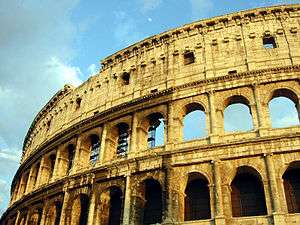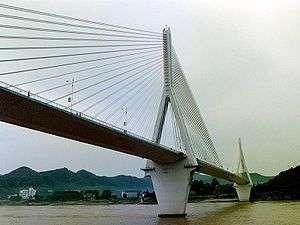Prestressed structure
A prestressed structure is one whose overall integrity, stability and security depend, primarily, on prestressing: the intentional creation of permanent stresses in the structure for the purpose of improving its performance under various service conditions.[1]

Naturally precompressed exterior wall of Colosseum, Rome

Cable-stayed prestressed concrete bridge over Yangtze river
The basic types of prestressing are:
- Precompression with mostly the structure's own weight
- Pre-tensioning with high-strength embedded tendons
- Post-tensioning with high-strength bonded or unbonded tendons
Today, the concept of a prestressed structure is widely employed in the design of buildings, underground structures, TV towers, power stations, floating storage and offshore facilities, nuclear reactor vessels, and numerous bridge systems.[2]
The idea of precompression was apparently familiar to ancient Roman architects. The tall attic wall of the Colosseum works as a stabilizing device for the wall piers beneath it.
References
- Nilson, Arthur H. (1987). Design of Prestressed Concrete. John Wiley & Sons. ISBN 0-471-83072-0.
- Nawy, Edward G. (1989). Prestressed Concrete. Prentice Hall. ISBN 0-13-698375-8.
This article is issued from Wikipedia. The text is licensed under Creative Commons - Attribution - Sharealike. Additional terms may apply for the media files.